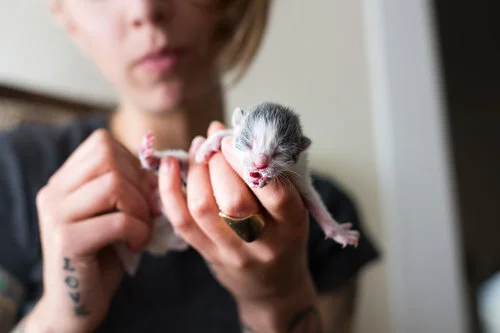Syringe Feeding
Bottle feeding is the standard method for feeding orphaned kittens, but if you're having difficulty feeding a kitten under 2 weeks old, you may want to consider switching from a bottle to a syringe. Before you get started, learn about the benefits and risks of syringe feeding!
A syringe can be greatly beneficial for kittens 0-2 weeks of age. Syringes make it easier to measure in small increments, so you can feel confident that the kitten has eaten a full meal. However, it does come with some risks, as very young kittens don't have a gag reflex and can easily aspirate if fed too quickly. Here's what you need to know if you're going to syringe feed a kitten:
1. Pick the Right Supplies
For small babies, I recommend a 3cc oral syringe (with no needle, of course!) You can find these online for less than ten cents a piece. In a pinch, ask your local veterinarian or animal shelter for a few 3cc syringes; they will definitely have some on hand.
Ideally, you will use the 3cc syringe in combination with a Miracle Nipple. The Miracle Nipple is a very helpful tool that fits on a bottle or on a syringe. The nipple comes in both small and large sizes, and is perfect for helping tiny kittens get a good latch. If no Miracle Nipple is available, it may be challenging to get a kitten to latch, and you may want to opt for a standard bottle.
You will also need to purchase kitten formula. Do not attempt to feed a kitten cow's milk or other dairy products, dairy alternatives, or human baby formula, as this can be dangerous or fatal for the kitten. Kitten formula can be purchased at most pet supply stores, or can be found in rural areas at feed stores. You can also buy it online by visiting the links on my supplies page.
Tip: Be sure to pick up at least a dozen syringes, as you don't want to use them over and over again, even if you're sanitizing them. Used syringes can operate less smoothly, making it harder and more dangerous to feed the kitten.
2. Assess the Kitten
Before you feed a kitten, always make sure you've assessed her to make sure it is safe to feed. If a kitten is overheated or too cold, it is not safe to feed until you have gently stabilized their temperature. If a kitten is not able to swallow, it is not safe to feed. If a kitten has a cleft palate, it may be riskier to feed. Be sure that you've assessed the kitten's temperature and body condition before feeding.
Ensure that the kitten is able to swallow by placing a drop of formula on their tongue and feeling the throat with one finger. If the kitten appears stable and is swallowing, proceed.
3. Feed the Kitten
Prepare the formula according to the manufacturer's instructions, making sure that it is fresh, clump free, and comfortably warm. Pull the formula into the syringe. Lay the kitten in a natural, belly-down position -- never, ever on her back. Gently slide the syringe into the kitten's mouth and slowly drip formula onto the tongue. The kitten should begin to swallow. Very slowly continue to drip formula into the mouth. If the kitten latches on and is suckling, that's great! Just make sure that she isn't eating too quickly; help the kitten keep a slow and steady flow.
Tip: Exercise extreme caution while syringe feeding--feed as slowly as possible to avoid aspiration.
Use this chart as a guideline for feeding. Remember that every kitten is different, and this is only a guideline--not a rule book!





